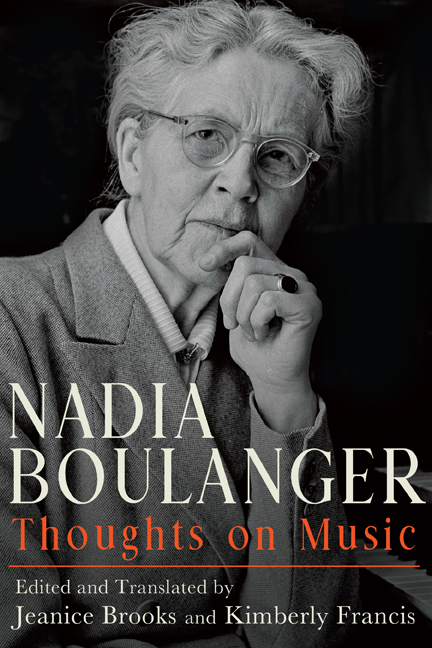Book contents
- Frontmatter
- Contents
- List of Illustrations
- Acknowledgments
- Editorial Apparatus and Critical Notes
- Note on Translations
- List of Abbreviations
- Timeline of Nadia Boulanger’s Life
- Introduction
- Part One Journalism, Criticism, Tributes
- Part Two Lectures, Classes, Broadcasts
- Bibliography of Nadia Boulanger’s Published Writing
- General Bibliography
- Index
“Igor Stravinsky” (Rice Institute Lecture no. 3, January 29, 1925), unpublished stenographer’s transcript (original English text)
Published online by Cambridge University Press: 15 October 2020
- Frontmatter
- Contents
- List of Illustrations
- Acknowledgments
- Editorial Apparatus and Critical Notes
- Note on Translations
- List of Abbreviations
- Timeline of Nadia Boulanger’s Life
- Introduction
- Part One Journalism, Criticism, Tributes
- Part Two Lectures, Classes, Broadcasts
- Bibliography of Nadia Boulanger’s Published Writing
- General Bibliography
- Index
Summary
Dr. Tsanoff
Ladies and gentlemen: For me, what I am about to do is a very pleasant superfluity for you, and for me an extreme pleasure, for truly, after the two lectures that Houston has already had from Mlle. Boulanger, we are all indebted to her, and therefore, do not require to be introduced to her. All the same, when I come to consider the lecture recital this evening, I am decidedly embarrassed, for I am reminded of the English lady that spoke to Turner, the English painter, on a certain occasion. She said, “Mr. Turner, I am told you paint wonderful sunsets, but I have never seen any such sunsets as you paint.” Turner said, “Yes, madam, but don't you wish you had?” Is it true that perhaps some of us, when we think of ultra modern music, are in the same position of the English lady? We are told that here are wonderful things to hear, and we wish we could hear them. I presume what the English lady required was an education of her sense of vision, and what we need is education of our ears. Perhaps, if God be willing and generous, through impressed familiarity we might gain an understanding. I am sure then that I am expressing the feelings of all of you, if I say how glad I am, and all of us, to have the privilege of being introduced to the music of what some say is the great ultra-modern, Igor Stravinsky. Ladies and gentlemen: Mlle. Boulanger. (Applause.)
Mlle. Boulanger
Ladies and Gentlemen: We have today, as Dr. Tsanoff has said, to speak of Igor Stravinsky.
Stravinsky was born in Oranienbaum in 1882. He wrote his first important work twenty years past, and in these twenty years, he has had such evolution that we have the greatest trouble to follow him. This example of rapidity, of spontaneity, and of tremendous will is what appeals first in the work of Stravinsky. The man, small of stature, gives an extraordinary feeling of strength, of concentrated strength, of power. When he is at the piano one feels that he can obtain from the instrument what he decides to have.
- Type
- Chapter
- Information
- Nadia BoulangerThoughts on Music, pp. 375 - 386Publisher: Boydell & BrewerPrint publication year: 2020



